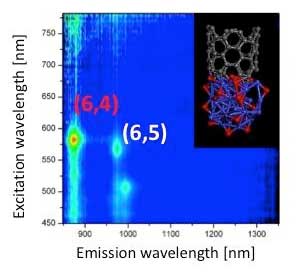| Posted: Sep 19, 2017 |
Novel strategy for chirality controlled synthesis of single-walled carbon nanotubes
(Nanowerk News) Researchers at Tohoku University have developed a novel strategy for controlling chirality of single-walled carbon nanotubes (SWNTs). By using this approach, preferential synthesis of (6,4) SWNTs has been realized for the first time (Scientific Reports, "Preferential synthesis of (6,4) single-walled carbon nanotubes by controlling oxidation degree of Co catalyst").
|
|
The unique growth mechanism has been elucidated through comparing experiments and theoretical calculations made with a researcher from the University of Tokyo.
|
 |
| (6,4) This is SWNTs grown by oxidation-degree control of Co catalyst. (Image: Toshiaki Kato)
|
|
Chirality-selective synthesis of single-walled carbon nanotubes (SWNTs) has been a research goal for the last two decades and is still challenging due to the difficulty in controlling the atomic structure in the one-dimensional material.
|
|
Led by Associate Professor T. Kato, the team demonstrated predominant synthesis of (6,4) SWNTs by tuning the oxidation degree of the Co catalyst. The detailed mechanism is investigated through a systematic experimental study combined with first-principle calculations, revealing that the independent control of tube diameter and chiral angle achieved by changing the binding energy between SWNTs (cap and tube edge) and catalyst causes a drastic transition of chirality of SWNTs from (6,5) to (6,4).
|
|
"Since our approach of independently controlling the diameter and chiral angle can be applied to other chirality species, our results can be useful in achieving the on-demand synthesis of specific-chirality SWNTs. This is, which is necessary for the practical use of SWNTs-based future devices such as ultra-high performance transistors, electrical and optical memories, and various sensor applications," says Kato.
|
|
"High purity synthesis of (6,4) SWNTs can contribute to pushing the study of SWNTs to industrial -- especially optoelectrical -- applications due to the largest band gap and highest quantum yields of (6,4) SWNTs."
|

